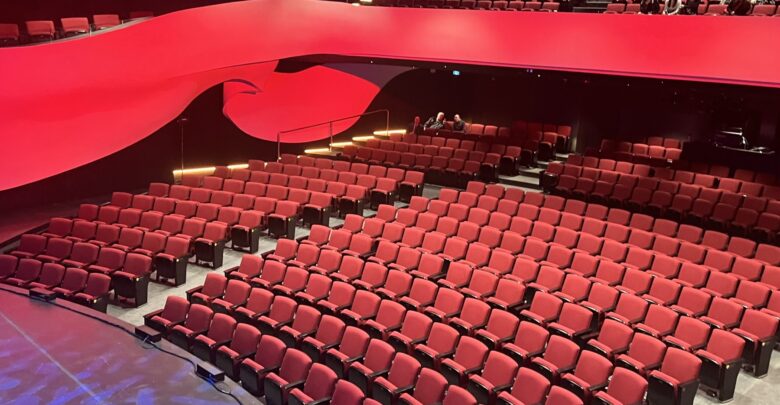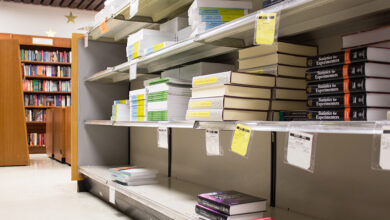 Leah Hennig
Leah HennigNew seats, a better sound system, a bigger lobby, solar panels, LED lights, gender neutral washrooms — what more could students want from the renovated Myer Horowitz Theatre? The University of Alberta Students’ Union (UASU) has been talking about renovating the Myer Horowitz Theatre since 2016. Now, there are only some finishing touches left before the project is officially complete.
But even when the UASU first started talking about this project, students seemed to be an afterthought. The UASU has consistently talked about the project as a need for the organization and the Students’ Union Building (SUB). They seemed set on this idea, even before students had their say — and after students rejected it. Additionally, the UASU completely failed to keep students informed about the changing price and increasing problems.
In 2018, the Student Events Initiative (SEI), a fee that would fund the renovation, went to referendum. Ultimately, it didn’t pass. This should have been a clear sign to the UASU that students didn’t want or support the theatre renovations. Or at least didn’t want to bear the financial burden of it. But the UASU ignored that.
The following year, the UASU proposed the Student Spaces Levy (SSL), which would go towards the renovations. Council shot it down before it even got to the ballot, after a baffling council meeting. Executives were openly recommending that they break bylaw to get the SSL on the ballot. The UASU was willing to break the rules to move forward with the Myer Horowitz project.
Another year later, the UASU put forward the third iteration of the fee to referendum. The Sustainability and Capital Fund (SCF) passed and months later the UASU approved its use for the Myer Horowitz renovations. But it wasn’t just a matter of using the money collected from the fee to pay for the costs. The UASU used the SCF to finance a loan to pay for the renovations. This means that for 25 years, a large portion of the SCF will be used to pay off the debt from the renovations.
Students rejected the SEI, which would have done the same thing. Yet the UASU found a way for students to pay off the debt anyways. Only now the project would supposedly be more sustainable. I’m not convinced that students thought a sustainability fee would or should go towards Myer Horowitz. But it did anyways.
In an interview with The Gateway, Marc Dumouchel, the UASU’s general manager, said that the SCF is about social and economic sustainability as well as environmental sustainability. But when most students, and honestly most people, hear “sustainability” they think environmental sustainability. When asked about that, Dumouchel said “whenever we’ve talked about the SCF we always talk about the three pillars of sustainability.”
However, in an interview with The Gateway, Levi Flaman, vice-president (operations and finance) (VPOF), only commented on the environmental aspect of the fee. If even the VPOF only thinks of the SCF as an environmentally driven fee, how are students that aren’t as engaged with the UASU supposed to know the other aspects of it?
But the UASU didn’t have to wait for the Myer Horowitz project to install solar panels, swap to LED lights, and improve energy usage efficiency. The UASU could have made sustainability efforts with or without these renovations. But tacking sustainability onto the project seemed to be an easy way to get student funding for it.
Even though the UASU made students stakeholders in this project, the UASU hasn’t kept students informed about it. According to Dumouchel, the final cost of the renovations is expected to be $27.5 million dollars. This is quite a bit higher than the earliest estimate of $11 million and the later $17.5 million.
Additionally, the UASU initially had a fundraising goal of $10 million. Eventually, the feasible amount for the UASU to find in external funding was $3 million. But the costs kept rising and the amount of external funding kept getting smaller. Now the UASU is only expecting external funding to pay for $700,000 of the project. This leaves students to pay the $26.8 million left over.
The costs kept rising and the amount of external funding kept getting smaller, yet the UASU hasn’t told students. Most students are likely still under the impression that the cost of the renovations is only $17.5 million and that external funding is accounting for a good chunk of that.
Dumouchel blamed factors out of the UASU’s control for the rising costs. One of the cost drivers was the COVID-19 pandemic, which created supply chain issues and made it difficult to find trades workers. Another contributing factor was the decision to include replacing the electrical vault in these renovations. But how are students meant to know any of this if the UASU isn’t telling them?
The Myer Horowitz renovations were a success for the UASU and SUB — but less so for students. The UASU has left students with an astronomical bill to pay off for the next 25 years. And most don’t know this, nonetheless the reasons for it. The UASU not only needs to communicate better with students, but needs to listen to them — even when they don’t like what students have to say.




